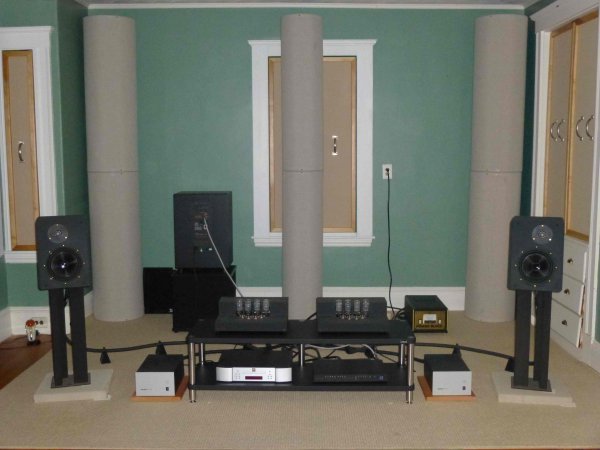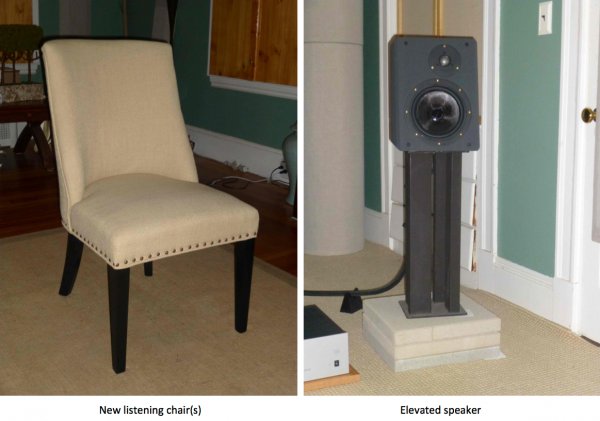There are some changes to my system. First, the issue of fighting with too little treble described above is resolved. The problem turned out only in part to have been due to acoustic changes.
A perhaps bigger part of the problem were tubes in my amps that were way past their prime. While 3 of the 8 power tubes measured a bit weaker (and were replaced too), it was especially the driver tubes. All eight of them, four per channel, had gone completely bad, as measured by their so-called transconductance which was far below the acceptable level. Steve Marsh, my tube amp specialist in Connecticut, measured them while the amps were on repair for two filament power supply rectifiers that were dying (the filaments were glowing less while amplification was still o.k.).
I had JJ E88CC driver tubes, and JJ tubes, while good sounding, are apparently known for a shorter life than others. I now have Sylvania JAN 6DJ8 military tubes that were produced up to at least the late 1970s (JAN = Joint Army Navy). They are NOS tubes (New Old Stock), just like the rectifier tubes in my external power supplies (I stocked up on those tubes quite a bit since they are not made anymore). Part of the reason the old tubes did not last that long was not just that they were JJ tubes, but also that the filament voltage of 7.4 V was too high, putting extra stress on the tubes. The 25-year old, yet heavily modified, amps were not designed for a voltage as high as 120 V, which is the norm these days. Steve Marsh who took care of the amps found an elegant solution: he mounted 0.2 Ohm power resistors that dropped the voltage to 6.6 V, much closer to the ideal level of 6.3 V.
The new tubes sound great, with convincing tonality and fantastic liveliness and dynamics. Bass is even tighter than before. As mentioned, I also have the high frequencies back.
Apart from having my amps revitalized, I also took care of a bass resonance ('hump') that I had not paid much attention to thus far, but which finally caught my ear (Ack mentioned it in his listening impressions on the previous thread page). The trick was to move the subwoofer 4 inches closer to the front wall, from 12 to just 8 inch distance. The bass is now significantly more even. Interestingly, moving the subwoofer away from the front wall did nothing to change the resonance.
Another change in my system is the tube trap configuration:
When experimenting with tube traps Madfloyd found that they can adversely affect midbass quantity, especially when stacked on top of one another, and I heard the same thing at his place. I was wondering if I could get more midbass if I reduced the surface of the corner traps in my room.
I decided to perform the following exchange (see below image, compare with earlier image in post #48 on the previous thread page):
1) replace the middle 13" wide traps with the top 16' traps from the two corner columns at the front wall
2) move the 13" traps on top of the bottom 16" corner traps
(all with their absorptive side into the room as usual lately)
The result seems to be that indeed I get more midbass, closer to what I hear in Madfloyd's system. In addition, the larger surface of the middle tube traps appears to somewhat move forward center images when they are recessed.
Interestingly, with this configuration images frequently become less pin-pointed, while still well localized. One might argue that this conforms better with the concert hall reality where you often do not get pin-point images, yet things are still localized in space as long as you sit close enough, and the hall acoustic is such, that the contribution of direct sound is greater than that of reflected sound (further back in the hall it inevitably becomes one big mono). On the other hand, on some recordings I still get pin-point imaging.






